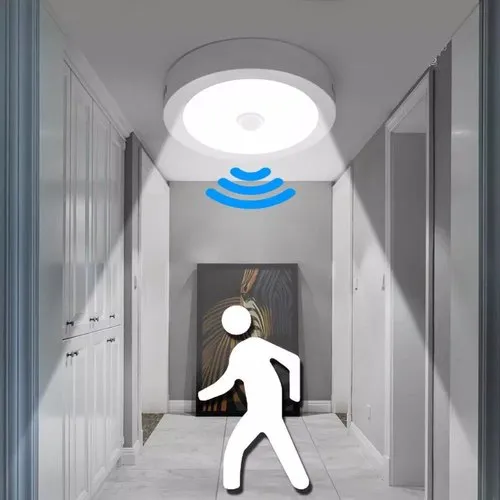Smart Motion Sensor Lights: What Are They For? How They Work, Applications, and Safe Usage Tips

Smart motion sensor lights have revolutionized the way we light our homes and offices, offering convenience, energy savings, and enhanced security. These innovative lighting solutions automatically turn on when motion is detected, making them a popular choice for modern homes and commercial spaces. In this article, we will explore what smart motion sensor lights are, how they work, where they are used, and important safety tips for using them effectively.
1. What Are Smart Motion Sensor Lights For? (Introduction, Common Types, and Benefits)
Smart motion sensor lights are a type of lighting technology that uses motion sensors to detect the presence of people or animals in a room or area and automatically turn the lights on or off. These lights are designed to offer hands-free operation, providing convenience and energy efficiency in various settings.
There are different types of smart motion sensor lights, including:
- Indoor Motion Sensor Lights: These lights are typically used in bedrooms, hallways, bathrooms, and kitchens, automatically turning on when you enter the room and turning off when no motion is detected for a certain period.
- Outdoor Motion Sensor Lights: Often used for security purposes, these lights are installed outside the house or building. They turn on when they detect motion near entrances, garages, driveways, or walkways, helping to deter intruders and provide visibility at night.
- Smart LED Motion Sensor Lights: These are energy-efficient lights that often come with adjustable features like brightness levels and timers. They connect to smart home systems, enabling users to control them remotely via smartphones or voice commands.
- Solar-Powered Motion Sensor Lights: These outdoor lights are powered by solar energy, making them environmentally friendly and cost-effective. They are typically used in areas where access to electricity is limited.
The key benefits of smart motion sensor lights include:
- Energy Efficiency: These lights automatically turn off when no motion is detected, reducing energy consumption and lowering electricity bills.
- Convenience: No need to manually turn lights on or off—motion sensor lights offer hands-free operation, making them ideal for high-traffic areas or dark spaces.
- Security: Outdoor motion sensor lights provide enhanced security by illuminating areas when motion is detected, alerting you to potential intruders.
- Extended Lifespan: Since the lights only turn on when needed, they tend to last longer, reducing the frequency of bulb replacements.
2. How Do Smart Motion Sensor Lights Work? (Principle of Operation and Key Components)
Smart motion sensor lights rely on sensors to detect movement and trigger the light to turn on. These sensors detect changes in the environment, such as movement or heat signatures, and communicate with the light source to activate or deactivate it.
Key components of smart motion sensor lights include:
- Motion Sensor: The core component of the system, motion sensors detect changes in the environment. There are different types of motion sensors, including:
- Passive Infrared (PIR) Sensors: These sensors detect heat emitted by humans or animals and trigger the light when movement is detected.
- Ultrasonic Sensors: These sensors use high-frequency sound waves to detect motion. They are often more sensitive than PIR sensors and can detect even slight movements.
- Microwave Sensors: These sensors emit microwave signals and detect the reflection of those signals when movement occurs. They are more sensitive than both PIR and ultrasonic sensors.
- Light Source: The light source can be an LED, halogen, or incandescent bulb, depending on the type of smart motion sensor light. LEDs are the most common due to their energy efficiency and longevity.
- Controller: The controller is the brain of the system, processing input from the motion sensor and activating the light. In smart motion sensor lights, the controller may also connect to a smartphone app or a smart home system like Alexa or Google Home.
- Power Source: These lights are typically powered by electricity, though some models, such as solar-powered motion sensor lights, use energy from the sun to operate.
When motion is detected, the sensor sends a signal to the controller, which activates the light. If no motion is detected for a set period, the light turns off automatically. This process ensures that energy is only used when necessary, making smart motion sensor lights highly efficient.
3. Where Are Smart Motion Sensor Lights Used? (Practical Applications)
Smart motion sensor lights can be used in a variety of settings, providing convenience, safety, and energy efficiency. Some common applications include:
- Residential Use:
- Hallways and Stairs: Smart motion sensor lights are commonly used in hallways, staircases, and corridors, where it’s inconvenient to turn lights on and off manually, especially in the dark.
- Bathrooms: Motion sensors in bathrooms provide automatic lighting when you enter, saving energy by turning off once you leave.
- Bedrooms: Motion sensor lights can be placed in bedrooms or closets to provide lighting when entering or exiting without fumbling for a light switch.
- Outdoor Use:
- Security Lighting: Smart outdoor motion sensor lights are widely used for security purposes. They are typically installed near entrances, garages, driveways, and pathways. The lights turn on when someone approaches, deterring burglars and providing visibility at night.
- Garden and Pathway Lighting: Solar-powered motion sensor lights can be used to illuminate gardens, driveways, or pathways, turning on when someone walks by and turning off when they leave the area.
- Commercial Use:
- Offices and Workplaces: Motion sensor lights can be installed in offices, hallways, and restrooms to provide energy-efficient lighting in commercial spaces.
- Retail Stores: In retail settings, these lights can be used to enhance security and provide a more efficient lighting solution in areas with irregular foot traffic.
- Public Spaces: Motion sensor lights are used in public spaces such as parking lots, bus stops, and parks to improve visibility and security.
In all of these scenarios, smart motion sensor lights enhance convenience, improve security, and save energy by automatically turning on and off based on movement.
4. How to Use Smart Motion Sensor Lights Safely (Safe Usage Tips and Important Considerations)
To ensure that smart motion sensor lights are used safely and effectively, follow these safety guidelines:
- Proper Placement: Install motion sensor lights in areas with adequate motion detection range. For outdoor lights, make sure they are placed high enough to avoid being obstructed by objects, and aim them at areas where they can detect movement effectively.
- Test the Sensor Range: Ensure the sensor’s range is set correctly. Some sensors can be too sensitive, turning the light on for small movements, while others may need adjustment to cover the desired area.
- Avoid Obstructions: Keep the area around the sensor clear of obstructions that might block its view, such as plants or furniture, which could interfere with motion detection.
- Adjust Sensitivity: Many smart motion sensor lights come with adjustable sensitivity settings. Fine-tune these settings to avoid false triggers from animals or small objects.
- Regular Maintenance: Clean the sensor and light fixture regularly to maintain optimal performance. Dust or dirt can affect the sensor’s ability to detect motion accurately.
- Use with Proper Voltage: Ensure the light is connected to the appropriate power supply. Overvoltage or incorrect wiring could damage the light or cause malfunction.
- Turn Off When Not in Use (If Applicable): In areas where constant motion detection is unnecessary, such as storage rooms, you may want to manually turn off the lights to save energy.
By following these guidelines, you can maximize the safety, efficiency, and longevity of your smart motion sensor lights.
Conclusion
Smart motion sensor lights offer a range of benefits, from convenience and energy efficiency to enhanced security. Whether used for home, commercial, or outdoor applications, these lights provide hands-free illumination that adjusts automatically based on motion. By understanding how these lights work, where they can be used, and the safety measures to follow, you can make the most of this innovative lighting solution.







